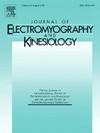Sex-specific effects of fatiguing handgrip plus blood flow restriction on upper limb neuromuscular characteristics during a repetitive shoulder height task
IF 2.3
4区 医学
Q3 NEUROSCIENCES
引用次数: 0
Abstract
Blood flow restriction (BFR) aims to accelerate reperfusion post-effort and could provide benefits after shoulder fatiguing work. However, sex-specific effects of localized BFR on whole-limb features are unknown. Ten females and eleven males performed three 30-second repetitive pointing tasks (RPTs) (pre-fatigue, post-fatigue, and recovery). The fatiguing protocol was an intermittent submaximal handgrip task performed until failure to meet the target force (50% of maximum grip strength). Participants completed two sessions: without BFR and with 50% BFR applied to the upper arm during the handgrip task. Electromyography was recorded during the handgrip and each RPT. Muscle thickness (ultrasound), and arm circumferences were recorded after each RPT sequence. Time-to-fatigue was unaffected by condition or sex. Females exhibited greater forearm electromyography amplitude and greater decreases in flexor carpi radialis and brachioradialis median power frequency (MdPF). Post-fatigue, forearm circumference and muscle thickness increased significantly in both sexes. Females demonstrated greater forearm muscle thickness changes, while males showed more consistent increases in biceps brachii thickness under BFR. During the RPTs, males displayed significant increases in MdPF of middle deltoid and pectoralis major, while females showed persistent fatigue effects in forearm muscles. Results suggest that sex differences exist in whole-limb mechanisms of fatigue and BFR adaptations.
重复性肩高任务中疲劳握力加血流限制对上肢神经肌肉特征的性别特异性影响。
血流限制(BFR)旨在加速运动后的再灌注,并可在肩部疲劳工作后提供益处。然而,局部BFR对全肢特征的性别特异性影响尚不清楚。10名女性和11名男性进行了3个30秒的重复性指指任务(rpt)(疲劳前、疲劳后和恢复)。疲劳方案是一个间歇性的次最大握力任务,直到未能达到目标力(最大握力的50%)。参与者完成了两个阶段:在握力任务中,上臂不使用BFR,上臂使用50% BFR。记录握力和每次RPT时的肌电图。每次RPT后记录肌肉厚度(超声)和手臂周长。疲劳时间不受条件或性别的影响。女性表现出更大的前臂肌电振幅和更大的桡侧腕屈肌和肱桡肌中功频率(mpf)的下降。疲劳后,男性和女性的前臂周长和肌肉厚度均显著增加。在BFR下,女性表现出更大的前臂肌肉厚度变化,而男性表现出更一致的肱二头肌厚度增加。在rpt过程中,男性中三角肌和胸大肌的mpf显著增加,而女性前臂肌肉持续疲劳。结果表明,全肢疲劳机制和BFR适应存在性别差异。
本文章由计算机程序翻译,如有差异,请以英文原文为准。
求助全文
约1分钟内获得全文
求助全文
来源期刊
CiteScore
4.70
自引率
8.00%
发文量
70
审稿时长
74 days
期刊介绍:
Journal of Electromyography & Kinesiology is the primary source for outstanding original articles on the study of human movement from muscle contraction via its motor units and sensory system to integrated motion through mechanical and electrical detection techniques.
As the official publication of the International Society of Electrophysiology and Kinesiology, the journal is dedicated to publishing the best work in all areas of electromyography and kinesiology, including: control of movement, muscle fatigue, muscle and nerve properties, joint biomechanics and electrical stimulation. Applications in rehabilitation, sports & exercise, motion analysis, ergonomics, alternative & complimentary medicine, measures of human performance and technical articles on electromyographic signal processing are welcome.

 求助内容:
求助内容: 应助结果提醒方式:
应助结果提醒方式:


